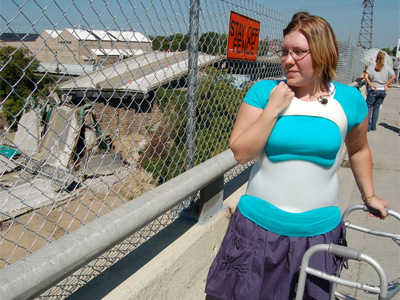
It’s been almost nine months since Lindsay Petterson rode her car from the I-35W bridge in Minneapolis into the water of the Mississippi River. She says people are losing “their understanding nature” and thinking she and other bridge victims “should be over it by now.”
She’s not over it by a longshot. “It’s just begun,” she said.
Pettersen told her story today to a conference of public safety and medical professionals, examining the psychological aspect of mass disaster.
Last August 1, she was on her way home from her job in Shoreview, where she worked in a group setting with children with mental health issues. “I heard the most distinct sound like a beam cracking in half, and my world changed forever,” she said. “I was in freefall. I don’t remember the fall, but I remember thinking ‘there’s no way I’m going to survive this.'”
Her car sank and filled with water immediately. Somehow, although she doesn’t remember how, she broke a window and surfaced, but not before “I changed my thought process to accepting this is how I was going to die.”
Pulled to safety by one of the construction workers who rode the bridge to the water, she ended up in the hospital with a fractured vertebrae for five days. Her physical injuries healed; her post-trauma stress has not. Not completely.
“I have a problem being in man-made structures. I walk into elevators and back out,” she said. “This roof as I’m speaking is making noises and it’s freaking me out. I have nightmares of falling that are as real as it was that day. I fear death. There was a tornado warning in my town, and I was sure it was going to come right down on my apartment building, and I would be the only one to die.”
Petterson says she’s sometimes angry, but mostly she’s sad. “It’s the most lonely feeling I’ve ever had in my life. I know that this sad person is not who I was. I know it’s not who I will be. But it’s who I am now.”
She’s unemployed now because she started thinking that maybe, if she made one of the kids mad at work, they’d hurt her. “I worked in a group home and I tried to help the kids but it was at a time when I needed help, too.” She says she’s hoping for the perfect job to come along.
In the meantime, she wants people to be nicer, and be more understanding about the psychological impact of the disaster. She pointed to comments that are attached to news sites’ articles. “There’s a lot of mean people who have a lot of mean things to say. It’s just not helpful,” she said.
She writes occasionally on a section of the Caring Bridge Web site. In her last entry — last week — she wrote:
I was also asked to speak on a panel at a conference next week about Disaster Response. I’m very honored that I will be able to share my story, both on that day and since. I think I’m going to go find a nice spot to enjoy the sunshine and do some reading. Thanks for putting up with my griping…
